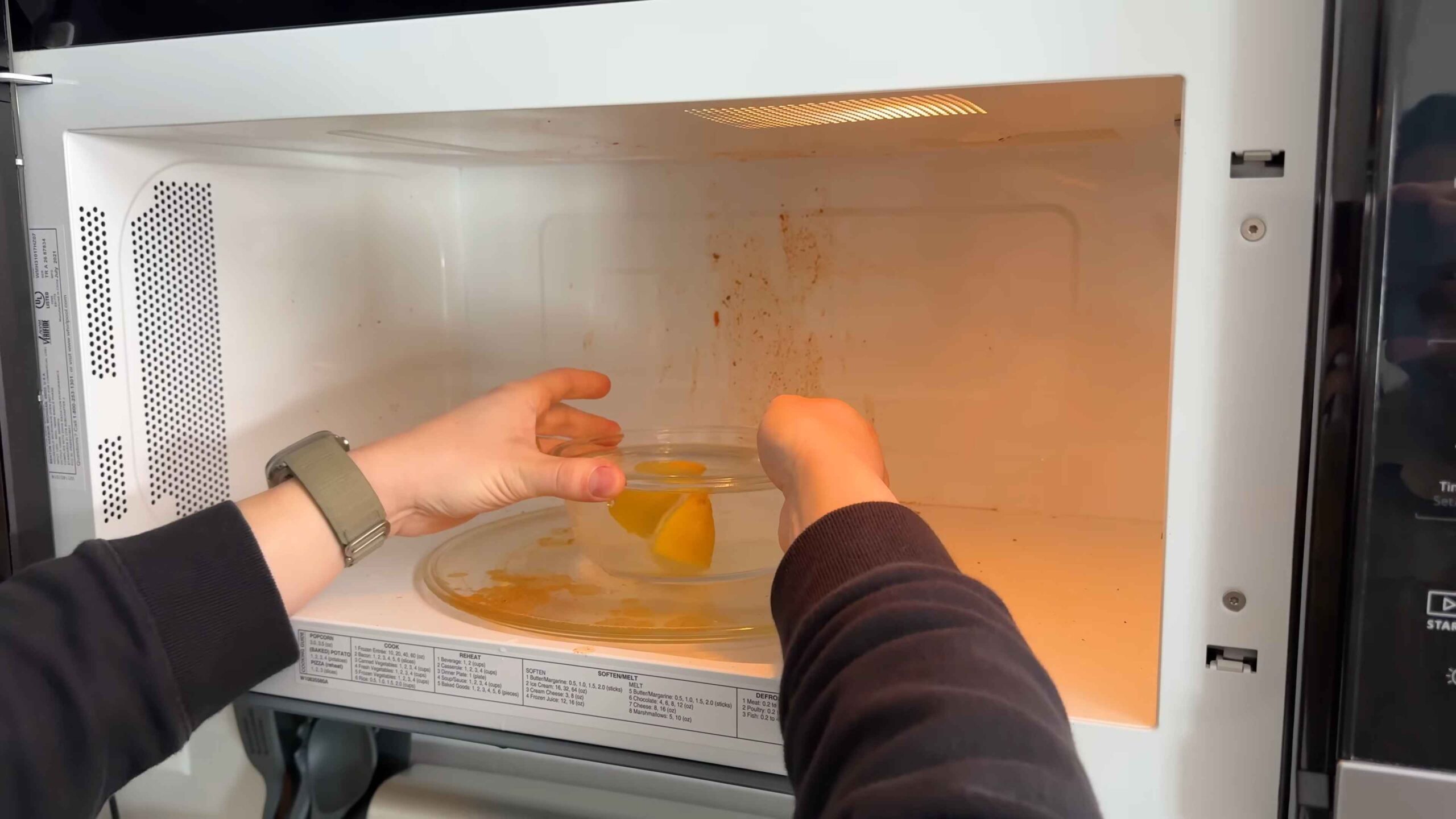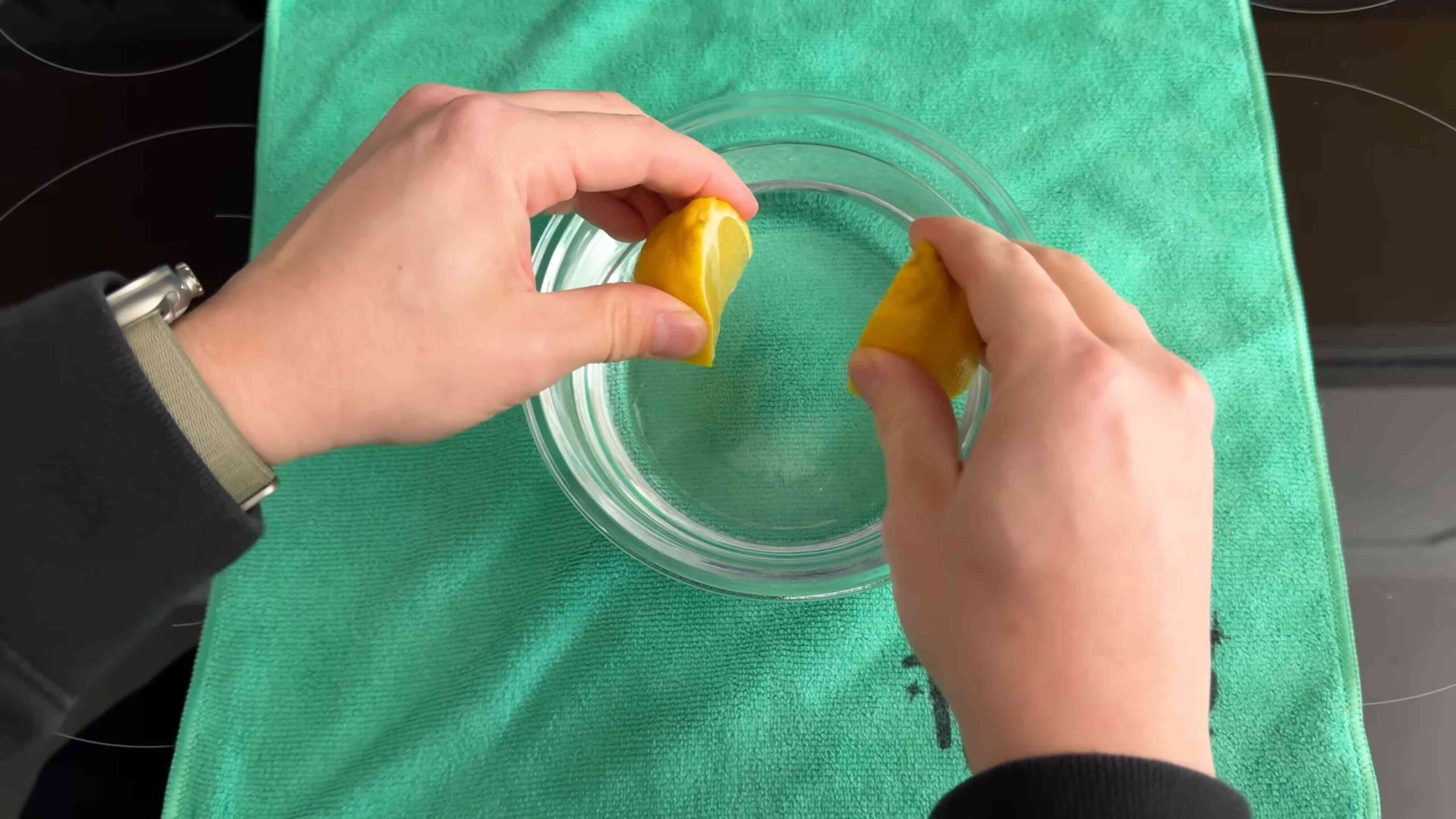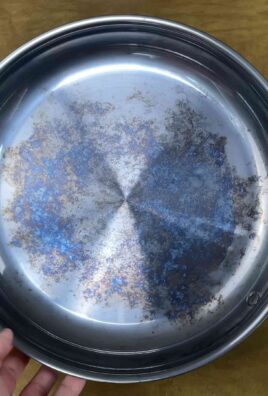Microwave cleaning citrus hack: Sounds too good to be true, right? I thought so too, until I tried it! Let’s be honest, cleaning the microwave is one of those chores we all dread. It’s a sticky, splattered mess that seems to defy all conventional cleaning methods. But what if I told you there’s a ridiculously easy, all-natural way to banish those food explosions and leave your microwave sparkling clean and smelling amazing?
Citrus fruits, particularly lemons and oranges, have been used for their cleaning power for centuries. Think about it – our grandmothers probably used lemon juice to brighten whites and disinfect surfaces long before harsh chemicals were readily available. This microwave cleaning citrus hack builds on that time-tested tradition, harnessing the natural degreasing and deodorizing properties of citrus to make your life a whole lot easier.
In today’s busy world, who has time to spend hours scrubbing a microwave? We’re all looking for quick, efficient, and eco-friendly solutions to everyday problems. This DIY trick is perfect because it requires minimal effort, uses ingredients you probably already have in your kitchen, and avoids the use of harsh chemicals that can linger in your microwave and potentially contaminate your food. So, ditch the elbow grease and get ready to discover the magic of citrus! I’m going to show you exactly how to use this simple hack to achieve a sparkling clean microwave in minutes.

DIY Microwave Cleaning Citrus Hack: Say Goodbye to Grime!
Hey everyone! I’m so excited to share this super easy and effective microwave cleaning hack with you. Forget harsh chemicals and hours of scrubbing – all you need is a citrus fruit (lemon, lime, or orange – your choice!), some water, and a microwave-safe bowl. This method uses the power of steam and citrus oils to loosen up all that splattered food and grime, making it a breeze to wipe clean. Trust me, your microwave will thank you!
What You’ll Need:
* A citrus fruit (lemon, lime, or orange)
* 1 cup of water
* A microwave-safe bowl (glass or ceramic works best)
* A clean sponge or cloth
* Optional: A few drops of your favorite essential oil (citrus scents work great!)
Step-by-Step Instructions:
1. Prepare the Citrus: First things first, grab your chosen citrus fruit. I usually go for a lemon because I love the fresh scent, but oranges work wonders too! Cut the fruit in half. You can either squeeze the juice into the microwave-safe bowl or simply place the halves directly into the bowl. I find squeezing the juice helps release more of those cleaning oils.
2. Add Water: Now, pour about 1 cup of water into the bowl. The water will create the steam that’s crucial for loosening the grime.
3. Optional: Add Essential Oils: If you want to boost the cleaning power and add an extra burst of fragrance, add a few drops of your favorite essential oil to the water. Lemon, orange, grapefruit, or even tea tree oil are all great choices. Just be sure to use pure essential oils and not fragrance oils.
4. Microwave the Mixture: Place the bowl with the citrus and water mixture into your microwave. Set the timer for 3-5 minutes on high. The goal is to bring the water to a rolling boil and let the steam fill the microwave. The exact time will depend on the power of your microwave, so keep an eye on it.
5. Let it Steam: Once the timer goes off, DO NOT OPEN THE MICROWAVE DOOR IMMEDIATELY! This is important. Let the steam work its magic for another 5-10 minutes. This allows the steam to really penetrate and loosen all the stuck-on food particles. The longer you let it sit, the easier the cleaning will be.
6. Carefully Remove the Bowl: After the steaming period, carefully remove the bowl from the microwave. The bowl and the water will be hot, so use oven mitts or a towel to protect your hands.
7. Wipe Down the Interior: Now comes the fun part – wiping away all that grime! Take your clean sponge or cloth and start wiping down the interior of the microwave. You’ll be amazed at how easily the food splatters come off. The steam and citrus oils have done all the hard work for you.
8. Pay Attention to Detail: Don’t forget to wipe down the top, bottom, sides, and door of the microwave. Pay special attention to any stubborn spots. If you encounter any particularly tough areas, you can dip your sponge or cloth into the citrus-infused water in the bowl and use it as a cleaning solution.
9. Clean the Turntable and Roller Ring: Remove the turntable and roller ring from the microwave. Wash them with warm, soapy water. These parts often accumulate food debris and grease, so give them a good scrub. Rinse them thoroughly and dry them before placing them back in the microwave.
10. Dry the Interior: Once you’ve wiped down the entire interior, use a clean, dry cloth to dry any remaining moisture. This will help prevent water spots and leave your microwave sparkling clean.
11. Enjoy Your Fresh, Clean Microwave! That’s it! Your microwave should now be clean, fresh-smelling, and ready to use.
Troubleshooting and Tips:
* Stubborn Stains: If you have some really stubborn stains that won’t come off with just wiping, try making a paste of baking soda and water. Apply the paste to the stain, let it sit for a few minutes, and then scrub gently with a sponge.
* Lingering Odors: If your microwave still has a lingering odor after cleaning, try placing a small bowl of baking soda inside and leaving it overnight. Baking soda is a natural odor absorber.
* Preventative Measures: To keep your microwave clean in the future, try covering your food with a microwave-safe lid or plastic wrap when heating it up. This will help prevent splatters and make cleanup much easier.
* Frequency: I try to do this cleaning hack at least once a month, or more often if I’ve had a particularly messy cooking session. Regular cleaning prevents grime from building up and makes the process much quicker and easier.
* Alternative Citrus: Don’t be afraid to experiment with different citrus fruits. Grapefruit can also be used, and it provides a slightly different, but equally refreshing, scent.
* Vinegar Option: If you don’t have any citrus fruits on hand, you can substitute white vinegar. Use the same method, but be aware that the vinegar smell might be a bit stronger. You can add a few drops of essential oil to mask the vinegar scent.
* Safety First: Always be careful when handling hot bowls and water. Use oven mitts or a towel to protect your hands.
Why This Hack Works:
The magic behind this hack lies in the combination of steam and citrus oils. The steam loosens the dried-on food particles, making them easier to wipe away. The citrus oils act as a natural degreaser and disinfectant, helping to break down grease and kill bacteria. Plus, the citrus scent leaves your microwave smelling fresh and clean.
Benefits of Using This Method:
* Natural and Non-Toxic: This method uses natural ingredients, so you don’t have to worry about exposing yourself to harsh chemicals.
* Effective: It’s surprisingly effective at removing even stubborn grime.
* Easy and Quick: The whole process takes just a few minutes.
* Affordable: All you need is a citrus fruit and some water, which are both inexpensive and readily available.
* Fresh Scent: It leaves your microwave smelling fresh and clean.
Maintaining a Clean Microwave:
Keeping your microwave clean doesn’t have to be a chore. Here are a few tips to help you maintain a clean microwave:
* Cover Food: Always cover your food with a microwave-safe lid or plastic wrap when heating it up. This will prevent splatters and make cleanup much easier.
* Wipe Up Spills Immediately: If you notice any spills or splatters, wipe them up immediately with a damp cloth. The longer you wait, the harder they will be to remove.
* Regular Cleaning: Make it a habit to clean your microwave regularly, even if it doesn’t look dirty. A quick wipe-down once a week can prevent grime from building up.
* Use Microwave-Safe Containers: Use microwave-safe containers to avoid food splattering and sticking to the inside of the microwave.
* Avoid Overfilling: Avoid overfilling containers when microwaving food. This can cause spills and splatters.
Beyond the Basics: Deep Cleaning Your Microwave
While the citrus steam hack is great for regular maintenance, sometimes your microwave needs a deeper clean. Here’s how to tackle those tough, baked-on messes:
1. Baking Soda Paste: As mentioned earlier, a paste of baking soda and water is excellent for removing stubborn stains. Apply the paste to the stain, let it sit for 10-15 minutes, and then scrub gently with a non-abrasive sponge.
2. Vinegar Soak: For really tough messes, you can try soaking the turntable and roller ring in a solution of equal parts white vinegar and water. Let them soak for at least 30 minutes, then scrub and rinse thoroughly.
3. Toothbrush for Tight Spaces: Use an old toothbrush to clean hard-to-reach areas, such as the corners of the microwave and the door seal.
4. Magic Eraser: A magic eraser can be surprisingly effective at removing stubborn stains and marks from the interior of the microwave. Just be sure to test it in an inconspicuous area first to make sure it doesn’t damage the surface.
5. Professional Microwave Cleaner: If all else fails, you can try using a professional microwave cleaner. Be sure to follow the instructions carefully and wear gloves to protect your hands.
I hope you found this DIY microwave cleaning hack helpful! It’s a simple, effective, and natural way to keep your microwave clean and fresh. Happy cleaning!

Conclusion
So, there you have it! This simple, yet incredibly effective, microwave cleaning citrus hack is a game-changer for anyone who wants a sparkling clean microwave without the harsh chemicals and elbow grease. Forget those store-bought cleaners filled with questionable ingredients; this method harnesses the natural power of citrus to loosen grime, eliminate odors, and leave your microwave smelling fresh and inviting.
Why is this a must-try? Because it’s quick, easy, affordable, and environmentally friendly. You likely already have the ingredients on hand – a lemon, lime, or orange, and a little water. The process takes just a few minutes, and the results are truly remarkable. No more scrubbing for hours or dealing with lingering chemical smells.
But the beauty of this microwave cleaning citrus hack lies in its versatility. Feel free to experiment with different citrus fruits. Grapefruit can add a slightly different scent profile, while a combination of lemon and lime offers a zesty punch. You can also add a few drops of your favorite essential oil to the water for an extra boost of fragrance. Lavender, eucalyptus, or tea tree oil are all excellent choices for their cleaning and aromatherapy properties.
For stubborn stains, consider adding a tablespoon of vinegar to the water. The vinegar will help to break down grease and grime even further. Just be mindful of the smell, as vinegar can be quite pungent.
Another variation is to use the citrus peels after you’ve juiced the fruit. Simply place the peels in a microwave-safe bowl with water and follow the same steps. This is a great way to reduce waste and get the most out of your citrus fruits.
We are confident that once you try this microwave cleaning citrus hack, you’ll never go back to your old cleaning routine. It’s a simple, effective, and enjoyable way to keep your microwave clean and fresh.
Don’t just take our word for it – give it a try! We encourage you to experiment with different variations and find what works best for you. And most importantly, share your experience with us! Let us know in the comments below how this hack worked for you, what variations you tried, and any tips or tricks you discovered along the way. We love hearing from our readers and learning from your experiences. Together, we can make microwave cleaning a breeze!
Frequently Asked Questions (FAQ)
Q: What kind of citrus fruit works best for this microwave cleaning hack?
A: While lemons are the most commonly used and highly recommended, limes, oranges, and even grapefruits work wonderfully. Each citrus fruit imparts a slightly different scent, so feel free to experiment and find your favorite. The key is the citric acid, which helps to loosen grime and grease. You can even combine different citrus fruits for a unique aroma. For example, a combination of lemon and lime provides a zesty and refreshing scent.
Q: Can I use bottled lemon juice instead of fresh citrus?
A: While fresh citrus is preferred for its natural oils and fragrance, bottled lemon juice can be used in a pinch. However, it may not be as effective as fresh citrus. If using bottled lemon juice, use about 2-3 tablespoons in the water. Keep in mind that the scent may not be as strong or pleasant as using fresh fruit.
Q: How much water should I use in the bowl?
A: You should use about 1 cup of water in a microwave-safe bowl. The water should be enough to create steam, which is essential for loosening the grime. Make sure the bowl is large enough to prevent the water from boiling over.
Q: How long should I microwave the citrus and water mixture?
A: Microwave the mixture on high for 3-5 minutes, or until the water boils and the microwave is filled with steam. The exact time will depend on the power of your microwave. Keep a close eye on it to prevent the water from boiling over.
Q: What if my microwave is heavily soiled?
A: For heavily soiled microwaves, you may need to repeat the process or let the steam sit for a longer period (up to 10 minutes) before wiping down the interior. You can also add a tablespoon of vinegar to the water for extra cleaning power. For particularly stubborn stains, you may need to use a non-abrasive sponge or cloth to gently scrub the area after steaming.
Q: Is it safe to use this method on all types of microwaves?
A: Yes, this method is generally safe for all types of microwaves. However, it’s always a good idea to check your microwave’s manual for any specific cleaning instructions or warnings. Ensure that the bowl you are using is microwave-safe to prevent any damage.
Q: What kind of bowl should I use?
A: Use a microwave-safe bowl made of glass, ceramic, or microwave-safe plastic. Avoid using metal bowls, as they can cause sparks and damage your microwave.
Q: How often should I clean my microwave using this method?
A: The frequency of cleaning depends on how often you use your microwave. As a general rule, cleaning your microwave once a week is a good practice to prevent buildup and maintain a fresh scent. If you use your microwave frequently, you may need to clean it more often.
Q: Can I add essential oils to the water?
A: Yes, adding a few drops of your favorite essential oil to the water can enhance the cleaning and deodorizing effects. Lavender, eucalyptus, and tea tree oil are all excellent choices. Be sure to use pure essential oils and avoid using synthetic fragrances.
Q: What if I don’t have any citrus fruits on hand?
A: While citrus fruits are the most effective for this hack, you can also use vinegar as a substitute. Mix equal parts water and vinegar in a microwave-safe bowl and follow the same steps. However, be aware that vinegar has a strong odor that may linger for a while.
Q: How do I prevent my microwave from getting dirty in the first place?
A: To prevent your microwave from getting dirty, cover your food with a microwave-safe lid or plastic wrap when heating it. This will prevent splatters and spills. Also, wipe down the interior of your microwave after each use to remove any food residue.
Q: What should I use to wipe down the microwave after steaming?
A: Use a clean, soft cloth or sponge to wipe down the interior of the microwave after steaming. Avoid using abrasive cleaners or scrub brushes, as they can damage the surface.
Q: My microwave still smells after cleaning. What should I do?
A: If your microwave still smells after cleaning, try placing a bowl of baking soda in the microwave overnight. Baking soda is a natural odor absorber and can help to eliminate lingering smells. You can also try repeating the citrus cleaning process.
Q: Can I use this method to clean other appliances?
A: While this method is specifically designed for cleaning microwaves, the principles of using steam and citrus to loosen grime can be applied to other appliances as well. For example, you can use a similar method to clean your oven by placing a bowl of water and citrus peels in the oven and heating it on low for a period of time. However, always check the appliance’s manual for specific cleaning instructions before attempting any DIY cleaning methods.





Leave a Comment